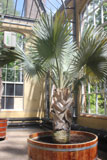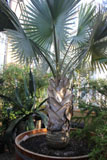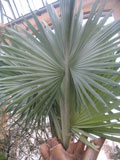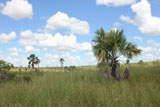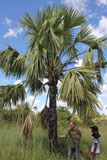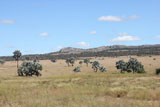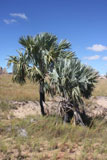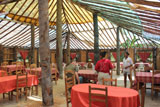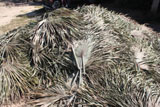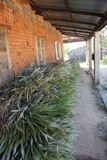|
|
||
A abridged version of this article was published before in the "Hortuskrant" of March 2012 of the "Botanical Garden of Amsterdam"
by Fred Triep
| In the just renovated Palm glasshouse grows the Bismarck palm. Not very rare, but a truly splendid palm. |
|
The Bismarck palm (Bismarckia nobilis) has been named after the famous Chancellor Bismarck in the nineteenth century, who has merged Germany. The palm is from Madagascar, the largest island in the world after Greenland, Borneo and New Guinea. Madagascar is home to many species of the palm family (Arecaceae). On the island occur 170 palm species (the much larger continent of Africa has only 65), of which 165 species are endemic, meaning that these species occur only in Madagascar.
Fire-proof palm
Bismarckia nobilis grows in Madagascar in the savanna landscape, that runs off from of the central plateau to the west and the northwest coast of the island. This grassy landscape has been created by the frequent burning of natural vegetation for agriculture. The Bismarck palm, travelers plant (Ravenala madagascariensis) and tapia (Uapaca bojeri) are relatively fire resistant and have become therefore important elements of this grassy vegetation. The photos below show the landscapes where the green variety (along the RN 34 from Mihandrivazo to Malaimbandy) and the gray variety (along the RN 7 from Ihosy to Toliara) occur.
The Bismarck palm is not threatened because it is widespread and occurs anywhere in reasonable numbers.
In Madagascar, the Bismarck palm has been named 'SATRA' or 'satrapotsy “after the village in Madagascar But also the name 'badika´ has used. The palm is widely used by the people. The trunks are smoothed and their boards can serve as fences, and from the leafs roofs and baskets are made.
At restaurant Badika at the RN 35 (Antsirabe-Morondava) are the poles, supporting the roof struts, from this palm. The roof is made of palm leaves, but this was at the time of shooting (april 2012) renovated. The old and the new palm leaves were waiting outside at the restaurant.
The genus Bismarckia is a
monotypic genus: it contains only the species Bimarckia nobilis. This species
built up fan-shaped, distributed round leaves.from the
top of the stem The leaves have been divided for
one-third of the dimensions into twenty or more parts, which are silver gray or
green. Outgrown leaves can have a diameter of three
meters.
Literatuur
Palmweb
www.palmweb.org
Bismarckia- Wikipedia, the free
encyclopedia
en.wikipedia.org/wiki/Bismarckia
Palmenfamile- Wikipedia
nl.wikipedia.org/wiki/Palmenfamile
John Dransfield and Henk Beentje
The Palms of Madagascar
Royal botanic
gardens Kew and the international Palm Society, 1995
This page has been created on Friday 22 June 2012.
![]()
For supplements or reacti
ons, send me an e/mail:
| Terug naar (return to): | Return to: |

